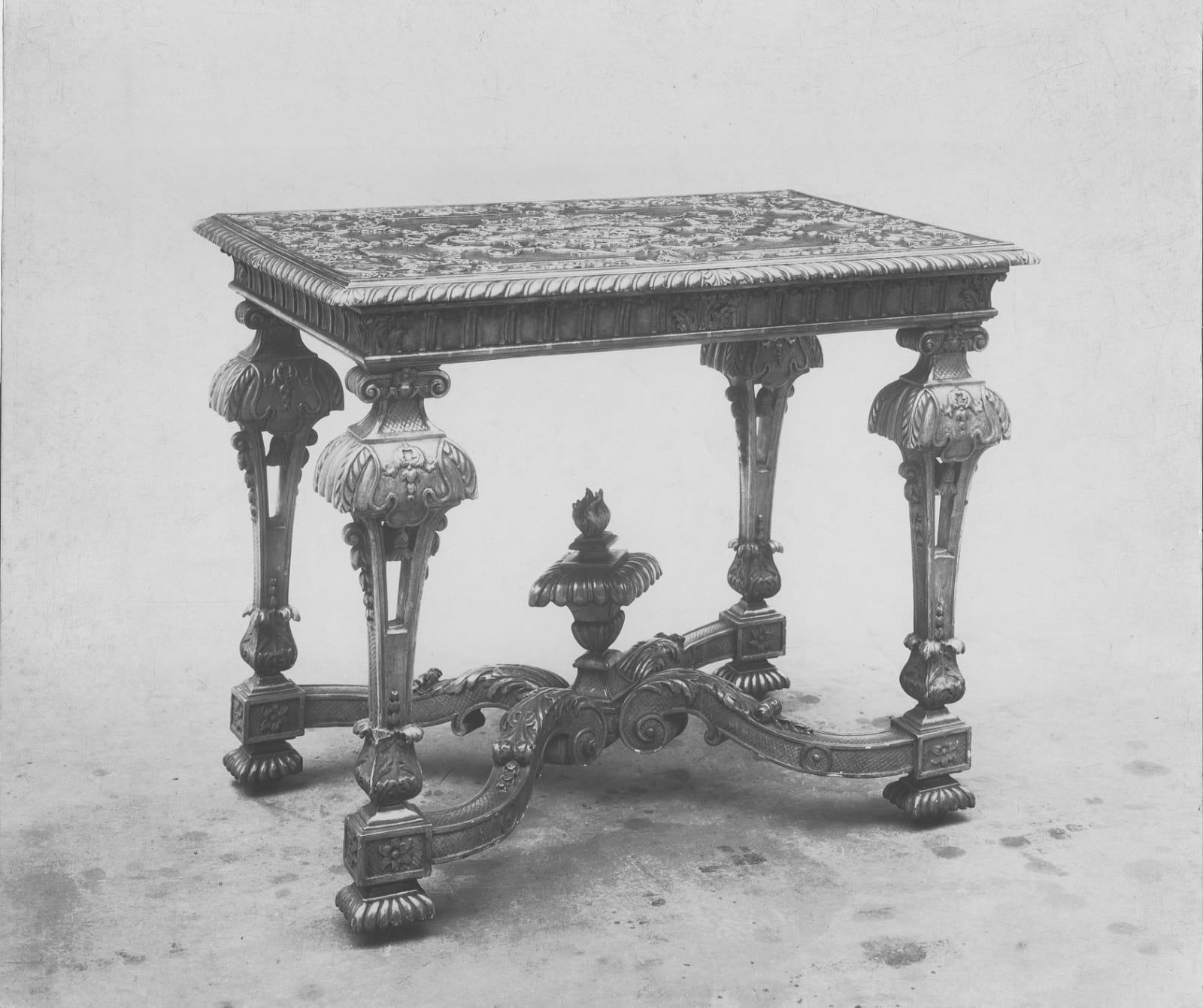
The table photographed probably circa 1900. Late 19th or early 20th century image in M. Harris & Sons photo archive with Ronald Phillips Ltd.
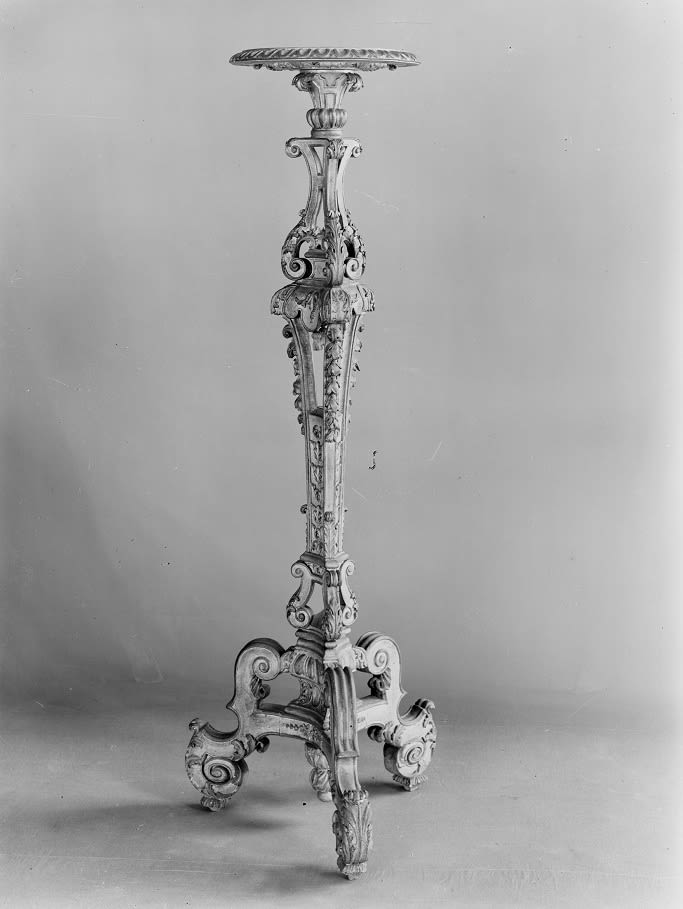
A stand made en suite with the table in 1699 for Kensington Palace. Courtesy of Country Life/Future Publishing Ltd.
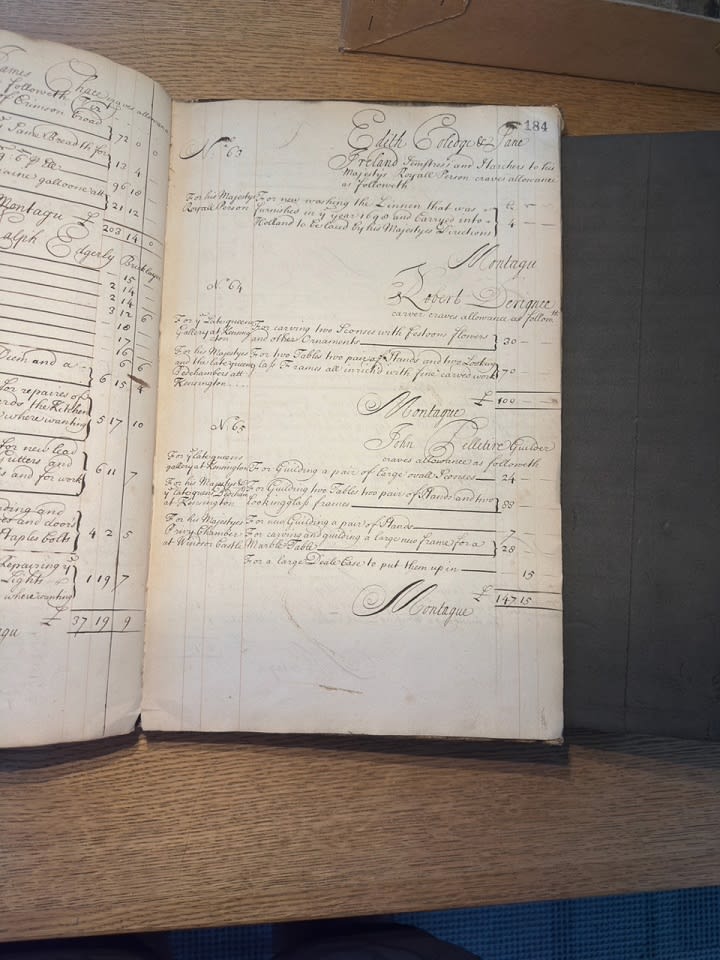
The bills recorded in the Lord Chamberlain’s accounts for 1696-1699. (The end date on the cover appears incorrectly as 1698.)
A TABLE FROM QUEEN MARY II’S BEDCHAMBER AT KENSINGTON PALACE, English, 1699
Width: 38 in; 96.5 cm
Depth: 24¾ in; 63 cm
Further images
-
(View a larger image of thumbnail 1
)

-
(View a larger image of thumbnail 2
)
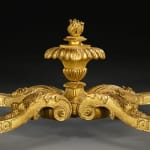
-
(View a larger image of thumbnail 3
)
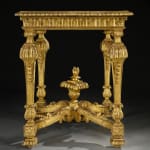
-
(View a larger image of thumbnail 4
)
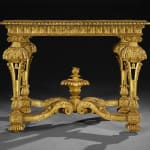
-
(View a larger image of thumbnail 5
)
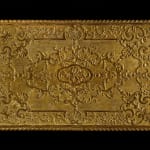
-
(View a larger image of thumbnail 6
)

-
(View a larger image of thumbnail 7
)

-
(View a larger image of thumbnail 8
)
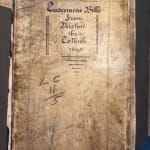
-
(View a larger image of thumbnail 9
)

A William and Mary giltwood and gesso side table carved by Robert Derignee and gilded by Jean Pelletier.
Note: The table retains much of the original gilding. The table has been carved and decorated on the reverse side at a later stage to create a centre table, and it was probably at this time that the lower parts of the pierced legs were filled in. The fluted frieze retains the exquisitely carved and undercut leaf scrolls above each flute. The flutes were each originally filled with a floral device on a pedestal, but these are now missing. The table was originally fitted with pendent strapwork aprons attached only on three sides of the table; these are now missing. The square vase-shaped finial in the centre of the stretcher is original and retains its large square hand-forged steel nail fixing.
The table belongs to an important group of giltwood furniture, all featuring the same distinctive lambrequin topped, pierced legs with carved tassels and, on the sides, scrolls with husks below them.
The suite was commissioned via Ralph Montagu, Master of the Wardrobe from 1689 to 1709, who was responsible for the furnishing of the Royal palaces, for the bedchamber of William III and his late Queen, Mary II, at Kensington Palace.
Queen Mary died in 1694, leaving William as sole monarch. He divided his time between Holland and England, spending most of it in the former. He had embarked on substantial renovations at Windsor Castle, St. James’s Palace and Kensington Palace, but his prolonged absences delayed decisions on the refurbishment. The largest project, however, took place at Hampton Court, where an entire new wing modelled on the Palace of Versailles was being built.
Gerrit Jensen supplied tables, cabinets and mirrors for the refurbishment, and Thomas Roberts supplied seating, consisting mainly of benches, stools and some side chairs and armchairs, as well as bed frames. From 1698 onwards, two notable Huguenot craftsmen began to deliver work as well: the carver Robert Derignée and the carver and gilder Jean Pelletier, together with Pelletier’s two sons, René and Thomas. Derignée and Pelletier brought with them new techniques and introduced gesso carving over the entire surface of a piece in order to simulate furniture made in solid silver or even gold. These innovations soon took hold, and other carvers and gilders quickly adopted and further developed the gesso carving technique.
Bills for the carving and gilding of this table and a second table as well as two pairs of stands and two mirrors have been preserved in the Lord Chamberlain’s accounts from the Royal Wardrobe of 1696-1699. The entry on page 184, no. 64, reads:
Robert Derignee, carver
Craves allowance as follow.
For y late queens Gallery at Kensington
For carving two Sconces w Festoons Flowers and other Ornaments £30 - -
For his Majestys & y late queens Bedchamber att Kensington
For two Tables two pair of Stands and two Looking glass frames £70 - -
£100 - -
Signed Montagu
The wording is important here: Derignée’s bill is for two tables rather than a pair of tables, and two pairs of stands rather than a set of four stands.
The following entry, no. 65, is for gilding the same pieces:
John Pelletire Guilder
Craves allowance as followeth
For y Late queens gallery at Kensington
For Guilding a pair of large oval Sconses £24 - -
For Guilding two Tables two pair of Stands and two Lookingglass frames £88 - -
For his Majestyes Privy Chamber at Windsor Castle
For new Guilding a pair of Stands £7 - -
For carving and guilding a large new frame for a Marble Table £28 - -
For a large Deale Case to put them up in
£-15s -
£147 15s -
Signed Montagu
It is important to note the distinction here between gilt tables and gilt frames intended for marble tops, and it is clear that the ‘large new frame’ had a top in a different material that did not require gilding. Our table, on the other hand, was carved and gilded all over, and therefore no mention of a carved gesso top was necessary.
Almost all of this important commission has been lost or dispersed over the years, and only a few pieces remain in the Royal Collection today, including two fire screens supplied for the King’s Apartments at Hampton Court, a set of eight stands (RCIN 1002) originally made for Hampton Court, a set of four stands (RCIN 57029) made for the Long Gallery (also called the Cartoon Gallery) and one pair of stands (RCIN 1015) belonging to our table. The companion (RCIN 31186) to our table has also survived. It no longer has a gesso top and has lost the middle section of the finial, but has retained the strapwork pendent apron on two of the three sides. The Doric capitals above the legs have also been lost or removed, but a faint shadow on the gilded surface indicates their original position. The fluted frieze has lost its over-scroll leaves above the arch of each flute, where the gilded surface has a slightly different colour, but the floral infills of each flute have been preserved.
From examination of our table and the Royal one, it is now possible to reconstruct their original design. The difference in width between the tables allows for variations in pier width in the Queen’s Bedchamber and its adjoining room. Only one table was placed in each room, standing against the middle pier. The piers to either side are close to the doorways connecting the rooms.
Many related table frames and stands remain in the Collection, but none have the distinctive pierced legs by which we were able to identify the table’s related torchères. Also virtually all the palaces’ furnishings have been moved many times since they were made more than three hundred years ago, making it very difficult to ascertain where each piece of furniture originally belonged.
Most of the surviving pieces in the Royal Collection have been re-gessoed and re-gilded. Our table however has escaped virtually unscathed, retaining much of the original gilding.
Provenance
For the late Queen’s Bedchamber at Kensington Palace;
M. Harris & Sons, London, England;
Private collection, Europe.
Literature
National Archives, LC11/5, Lord Chamberlain’s Department, account of Ralph Montagu, Master of the Great Wardrobe, Tradesmen’s Bills from Michaelmas 1696 to Michaelmas 1699, p. 184, nos. 64 & 65.
Ralph Edwards, The Shorter Dictionary of English Furniture, 1964, p. 581, fig. 15.
Geoffrey Beard and Christopher Gilbert, The Dictionary of English Furniture Makers 1660-1840, 1986, p. 687.
Tessa Murdoch, ‘Jean, René and Thomas Pelletier, a Huguenot family of carvers and gilders in England, 1682-1726: Part I’, Burlington magazine, November 1997, pp. 732-42.
Tessa Murdoch, ‘Jean, René and Thomas Pelletier, a Huguenot family of carvers and gilders in England, 1682-1726: Part II’, Burlington magazine, June 1998, pp. 363-74.






